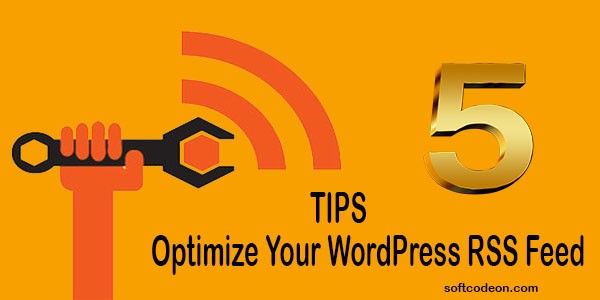
RSS is one of those technologies that are very simple yet much powerful. Optimize Your WordPress RSS Feed. Currently, RSS is the real model for blog syndication, and it is used broadly in both personal and corporate settings; for example, in websites/blogs. And because a huge percentage of these blogs work on WordPress, we’ll include in this post some practically useful RSS-related tricks and cabs that will help you use RSS in a more powerful way and without additional and stout WordPress plug-ins.
Why Optimize Your WordPress RSS Feed?
RSS feeds offer a way for your users to subscribe and view your blog posts in their preferred feed reader apps like Feedly. Even though feed users aren’t as common as they once were, there are still many users who favor reading WordPress blog content this way. By optimizing your RSS feed you can also stop content scraping, get more backlinks, send traffic to your site, and more. With that said, let’s get into our specialist tips for Optimize Your WordPress RSS Feed.
1. Protect RSS Feed From Scrapers
Content scraping is when content is taken from your website/blogs, normally via your RSS feed, and republished on other websites as their own. It can be very infuriating to see someone taking your content without your permission, monetizing it, and even exceeding your website in the search results. Happily, you can customize your RSS feed to really benefit your site if others steal your content via your RSS feed.
2. Create an RSS Feed Sitemap
An RSS sitemap is modified from an XML sitemap. RSS sitemaps only hold your most up-to-date content, which helps Google to keep your content fresher in search results. If you publish content regularly, then this can lead to a boost in your search engine rankings.
All in One SEO, lets you add an RSS sitemap to your website quickly, without having to code.
The primary thing you need to do is install and activate the All in One SEO plugin. AIO SEO enables RSS sitemaps automatically, so there’s nothing else you are required to do.
If you’d like to double-check, simply go to All in One SEO » Sitemap and then click on the ‘RSS Sitemap’ tab.
You can notice that the “Enable Sitemap” toggle option in the ‘RSS Sitemap’ box is now allowed.
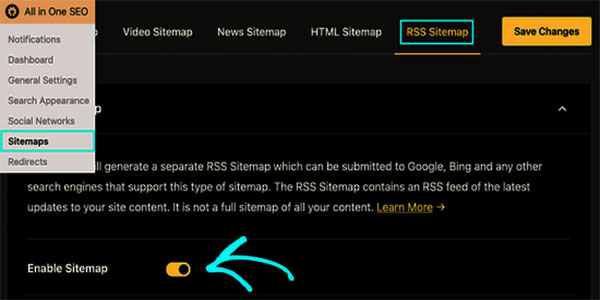
You can also set the number of posts you need to include in the ‘Sitemap Settings’ box.
We’ll drop the default settings, but you can include more articles or only include certain article types.
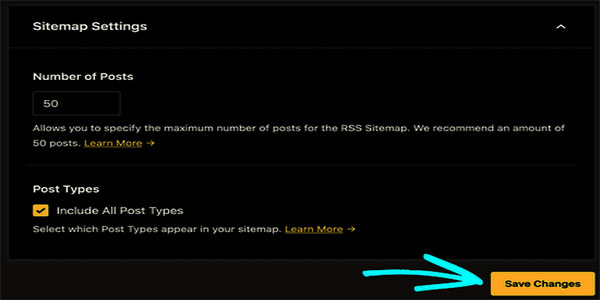
Before you leave the screen, make sure to click the ‘Save Changes’ button.
Now you’ve enabled your RSS sitemap for your website.
3. Show Excerpt Instead of Full Article in RSS Feed
Showing your full article in the RSS feed allows your users to read the whole article in their feed reader. This can negatively touch your page views, advertisement revenue, and growth rates.
By showing the article review instead of the full article in your RSS feed, you need users to come to your WordPress website to read the full post.
WordPress comes with a built-in solution. Simply go to Settings » Reading in your WordPress admin dashboard.
Then, scroll down to the section titled ‘For each post in a feed, include’ and select the ‘Excerpt’ radio button.
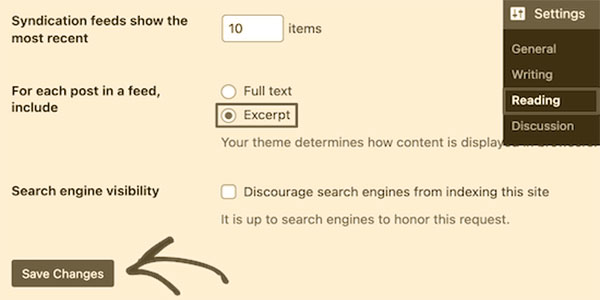
You can also check the number of articles that perform in your RSS feed as well.
In the Syndication feeds show the most recent box, simply enter a number into the box.
Before you leave this screen, make sure to click the ‘Save Changes’ button to update your RSS feed settings.
4. Add a Featured Image to Posts in RSS Feed
By default, WordPress does not add your post featured pictures to your RSS feed. When your readers see your post in a feed reader, they’ll usually pick the first image in your post. You can change this by putting a simple code to your WordPress files.
All you want to do is add the following code to your functions.php file, in a site-specific plugin, or by using FTP.
function sft_rsstutorial_featuredimage($content) {
global $post;
if(has_post_thumbnail($post->ID)) {
$content = '<p>' . get_the_post_thumbnail($post->ID) .
'</p>' . get_the_content();
}
return $content;
}
add_filter('the_excerpt_rss', 'sft_rsstutorial_featuredimage');
add_filter('the_content_feed', 'sft_rsstutorial_featuredimage');5. Allow Users to Subscribe to RSS Feed via Email
Not all your readers need to use a feed user to subscribe to your posts. A lot of people will fancy subscribing by email instead. That’s one cause why having an email newsletter is important for a website.
We suggest using Mailerlite to send RSS emails automatically. It’s a general email marketing service provider that has an always-free plan to send up to 400 emails a day 12000 a month.
Once your email list is set up, you can automatically send RSS emails when you declare a new blog post.
We hope this article helped you learn how to optimize your WordPress RSS feed.
2 Comments
Leave a Reply
You must be logged in to post a comment.


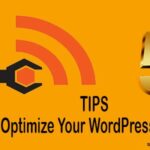


Impressive!Thanks for the post
Great helpful